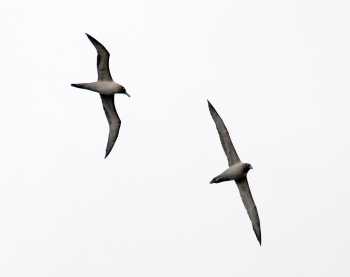In the austral summer of 2008/2009 a breeding colony of Light-mantled Albatrosses Phoebetria palpebrata (c. five pairs) was discovered on a small offshore rock ("Flat Top") connected to the Fildes Peninsula, King George Island, South Shetland Islands at 62° 12'S, 59° 01'W. On 17 December 2011 up to five Light-mantled Albatrosses were seen a little farther south in the Bransfield Strait at 63º 03'S, 57º 59'W (click here).
Also in December 2011 Kim Crosbie of the International Association of Antarctica Tour Operators (IAATO) recorded about 11 Light-mantled Albatrosses flying around the ship while at Livingston Island (62° 36′S, 60° 30′W) and through Boyd Strait and around Deception Island (62° 58′S, 60° 39′W). Sightings were also made of one or two individuals in the southern Gerlache Strait at this time.
A year earlier, John Chardine (Environment Canada) saw up to six birds, including a pair undertaking an assumed courtship flight, behind Walker Bay, Livingston Island, South Shetland Islands on 10 December 2010. He reports: "Above a rocky hill behind the beach at approximately 62° 39′S, 60° 37′W, I observed and photographed a seeming pair of Light-mantled Sooty Albatrosses flying relatively low over the land in what looked like a courtship display. Over the next 30 minutes I observed up to six birds at one time flying over the hill. The habitat looked suitable for breeding with multiple rocky ledges. These did not look to me like birds that were at-sea and incidentally flying over land at the time I saw them. I concluded to myself that they were breeding there or at least prospecting." If Light-mantled Albatrosses do breed at this site it will be yet another southerly extension of their known breeding range and the second breeding locality for the Antarctic Peninsula region - and within the Antarctic Treaty System region.

Two Light-mantled Albatrosses fly together over Walker Bay, Livingston Island, South Shetland Islands, 10 December 2010
Photograph by John Chardine
While working as a guide on the Antarctic Dream on 17 December 2011 Lex van Groningen landed in Dorian Bay on Wiencke Island and briefly saw two Light-mantled Albatrosses flying over the Gentoo Penguin Pygoscelis papua colonies at Damoy Point (64° 49′S, 63° 32′W), the most southerly record for the species I have found for the Antarctic Peninsula region to date.
Four Light-mantled Albatrosses fitted with satellite PTTs for a few weeks during chick-rearing and c. 10 birds fitted with GPS loggers for a single trip during incubation have been tracked from Bird Island, South Georgia (Islas Georgia del Sur)*. The farthest south that any of them reached was 62° 18′S in the Antarctic Peninsula region, and 64° 54′S in the eastern Weddell Sea.
Black-browed Albatrosses Thalassarche melanophris have been seen occasionally from the British Antarctic Survey base at Rothera Point, Adelaide Island (67° 34'S, 68° 08'W), thought to have followed ships south.
More southerly records of albatrosses in the Southern Ocean than those reported here will be welcomed ... and let's hope someone can take a closer look at those Walker Bay birds!
References:
Lisovski, S., Pavel, W., Weidinger, K. & Peter, H.-U. 2009. First breeding record of the light-mantled sooty albatross (Phoebetria palpebrata) for the maritime Antarctic. Polar Biology 32: 1811-1813.
Milius, N. 2000. The birds of Rothera, Adelaide Island, Antarctic Peninsula. Marine Ornithology 28: 63-67.
Phillips, R.A., Silk, J.R.D. & Croxall, J.P. 2005. Foraging and provisioning strategies of the light-mantled sooty albatross at South Georgia: competition and co-existence with sympatric pelagic predators. Marine Ecology Progress Series 285: 259-270.
With thanks to John Chardine, Kim Crosbie, Richard Phillips and Lex van Groningen for information.
John Cooper, ACAP Information Officer, 12 January 2012
*A dispute exists between the Governments of Argentina and the United Kingdom of Great Britain and Northern Ireland concerning sovereignty over the Falkland Islands (Islas Malvinas), South Georgia and the South Sandwich Islands (Islas Georgias del Sur y Islas Sandwich del Sur) and the surrounding maritime areas.

 English
English  Français
Français  Español
Español